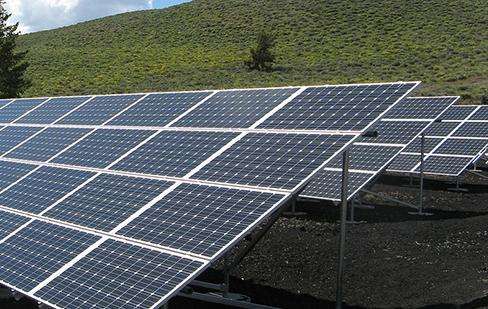Solar power generation can be divided into three forms: 1. Fixed support 2. Single-axis tracking 3. Dual-axis tracking
Fixed type: consists of a foundation and of a support Photovoltaic panels. do not shoot with sunrise and sunset. Each region has different tilt angles to the sun, so the angle of the ground support is also different. The advantages are: stability and low maintenance costs. More efficient than a single axis when daylight hours are short.
Single-axis tracking: It consists of a foundation and a support with a horizontal axis of rotation. It can follow the rotation of the sun in the horizontal direction, it can be used for more years. hours than fixed type, so the power generation capacity is large. (Implementation method: Horizontal tracking of photovoltaic panels is achieved by rotating the motor shaft) However, the labor costtenance is high and in windy weather, the engine is easy to burn out due to small motors or other factors.
Dual-axis tracking: It consists of a foundation and a special support. In addition to installing photovoltaic solar modules, the bracket is equipped with a horizontal axis motor and a vertical axis motor respectively, so that it can rotate according to the changes of the sun throughout the day, with the highest return and low investment. Most importantly, the maintenance cost is high and it is generally not used for large-scale grid-connected power generation.
Motor tracking: There is a bracket on the shaft and photovoltaic panels are installed on the bracket. You just need to rotate the shaft to achieve this. (The annual sunshine hours of large photovoltaic power plants are less than 3,200 hours and it is recommended to fix them)
Normally, the power of the sun is used to turn the Motor and rotate the inertial wheel to generate a reaction force to adjust the attitude of the satellite. There is chemical fuel inside the satellite. Once the low-Earth orbit satellite is exhausted, it will basically be scrapped and will gradually be pulled into the atmosphere by Earth's gravity! I want to know how to fly? For example, when a satellite changes orbit, it injects fuel. The reaction of the fuel injection will cause the satellite to move forward or change trajectory. In ordinary times, it only depends on solar energy. make the satellite fly forward?
Since the materials used to make artificial satellites are not ordinary materials, the shells of many satellites are basically made of titanium alloys, and titanium alloys can operate at temperatures ofe 450 to 500°C for a long time, It is therefore said that even if there is no atmospheric ozone layer in the universe, the artificial satellites themselves will not be afraid of direct light of the sun.
Moreover, artificial satellites not only are not afraid of the sun, but they also like to bask in the sun. Since artificial satellites are generally small in size and the existing volume needs to be filled with a large number of high-precision equipment, artificial satellites cannot generate electricity by themselves. After all, artificial satellites cannot produce electrical equipment such as motors. .
So what do artificial satellites rely on for energy? It's solar energy. Each time an artificial satellite moves to the side facing the sun, the artificial satellite unfolds its own solar panels to charge the volume-limited battery, aOnce full, he retracts the solar panels and uses his own. battery. The electricity works by itself.
If this is how a satellite moves around the Earth in a correct orbit, once launched it will automatically go into orbit due to Earth's gravity as it floats in space. The earth rotates in revolution.
As there is no gravity in space, the satellite to be launched must be in a near-low Earth orbit. Personally, I think that even if the satellite is in a gravity-free state in space, it is. always within the framework of Earth's gravity.














